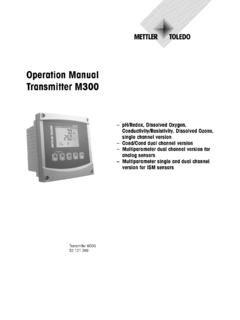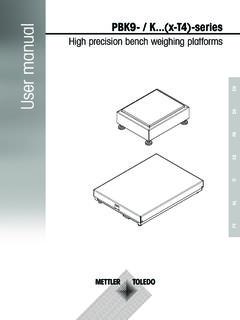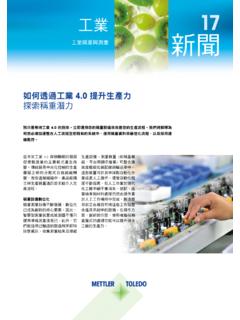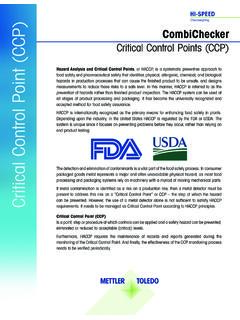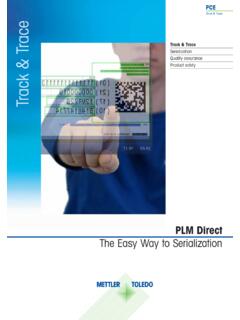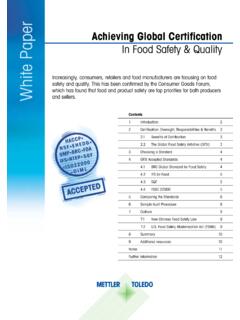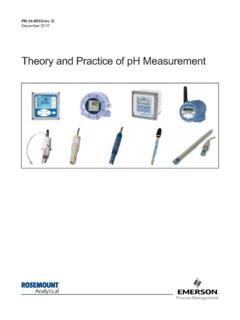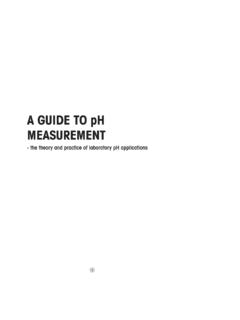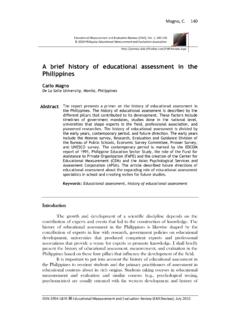Transcription of Measuring pH Correctly - Mettler Toledo
1 Measuring pH Correctly Pharma Conference GEP-Good Electrochemistry Practice November,18 - Cairo 1 Agenda Introduction Sensor Sample FAQ Examples 2 Introduction Good practice needed for consistent accurate results = Widely used technique and appears to be straight But: many possibilities for errors in the whole system -Meter -Environment -People -Documentation -Electrode -Sample Only correct usage and maintenance of the system guarantees reliable results 3 Introduction Installation and qualification are crucial Due to time reasons only shortly discussed here Necessary to make sure that the systems works according to manufacturer s specifications at your site ..and is suitable for your purpose.
2 Which is proven with suitable documentation 4 Introduction Calibration of sensor inputs Once to twice annually as part of operational qualification In case of problems: first make sure meter is not the cause Sometimes the meter or electrode cable has a short -No signal due to working electrode -Ease to verify (other cable, resistors) Get certificates for prove Calibration service can be included in service contracts 5 Introduction Environment During installation qualification, the suitability of the environment must be verified Appropriate temperature Minimal temperature fluctuations Humidity appropriate Avoid strong air flow close to the meter Have enough space to work (accidents) 6 Introduction Training The more you aware of possible risks, the better you can minimize them Ensures correct handling of the system Saves time troubleshooting Helps understanding possibilities and limits of the Measuring system Documentation If is not documented, it is not done Ensures traceability Supports legal requirements 7 Agenda Introduction Sensor Sample FAQ Examples 8 Sensor Daily tasks Electrode preparation Electrode storage Electrode cleaning Electrode calibration Longer lifetime (saves money) Constantly reliable results Fewer problems (saves time)
3 To get 9 Electrode lifetime Sensor The pH sensitivity of the gel layer sinks with age The aging process is temperature dependent Example lifetimes at different temperatures (same usage) assuming : Application of good practices with measurement in aqueous solutions and pH range 1 to 12 Temperature Approximate Lifetime Room temperature 1 to 3 years 90oC 3 to 9 months 120oC 6 to 12 weeks 10 Sensor Electrode lifetime Electrodes don t last forever and have to be replaced sometimes Aging depends also on handling, sample, frequency of usage Indication of too old electrode X slower response times X higher membrane resistance X smaller slope X bigger offset 11 Sensor Electrode preparation reference electrolyte Replace reference electrolyte regularly ( once per months) Less crystallization at the diaphragm Less impurities in the electrolyte Constant high ion concentration !
4 Don't fill up, empty it completely Fill it again using fresh electrolyte Electrolyte level in electrode must be higher than the sample Avoid the reflux of sample into the electrode (contaminations) No air bubbles behind junction Vertical shaking of electrode to get rid of them 12 Sensor Electrode preparation dry membrane Cause Measuring in non-aqueous or ion deficient media Wrong storage Effect Reduced sensitivity of glass (gel layer washed out ) Unstable signal Action Conditioning in mol/L HCl during 12 hours 13 Sensor Electrode preparation out-of-specs Cause Age in general Usage for samples which attack the glass Effect Offset too big and slope too low Unstable signal and sluggish response Action Reactivation of membrane: place electrode in reactivation solution (NH4HF2) for 1-2 minutes Replace the electrode !
5 14 Sensor Electrode storage Objective Ensure that the pH sensitive gel layer which forms on the pH glass membrane remains hydrated and ion rich Always store In inner electrolyte ( 3 mol/L KCI) In buffer solutions ( pH 4 or 7) In HCl diluted (approx. mol/L) Together with sample (same conditions) Never store Dry, in distilled water or non-aqueous solutions Reduces lifetime Needs conditioning before use (costs time) Open for measurement (pressure) Close for storage (contamination) 15 Sensor Electrode cleaning Aqueous sample Rinse with distilled water after every measurement (contamination of next sample) Dip it dry with paper towel ! Never wipe it with paper towel (electrostatics) Non-aqueous or dirty sample First rinse with solvent to get rid of dirt which is not water soluble Rinse with distilled water, dip it dry Condition in aqueous solution 16 Sensor Electrode cleaning - diaphragm Blocked with silver chloride (AgCl) With concentrated ammonia Blocked with silver sulfide (Ag2S)
6 With 8 % thiourea in molar HCl Blocked with proteins With 5 % pepsin in molar HCl Other junction blockages In ultrasonic bath with water or molar HCl Treat one hour, rinse with distilled water, and perform a new electrode adjustment 17 Sensor Electrode calibration Possible errors X Not done frequently enough X Done at a different temperature than subsequent measurement X Wrong or contaminated buffers used Actions Calibrate at least once per day, more if high temperature fluctuations Make sure conditions at calibration and measurement (temperature, stirring etc.) are equal Always use fresh buffers if buffers not accurate, pH calibration is not accurate and the measurement will not be accurate Perform at least a two point calibration Make sure the calibration points frame the expected sample pH 18 Sensor Electrode calibration buffer handling Buffers have expiry date don t order in bulk Store well sealed at room temperature Take out needed amount and close bottle immediately again Never calibrate electrode directly in the bottle Never re-use already used buffer solution Take single-use buffer sachets Buffers are testing equipment !
7 19 Sensor Electrode calibration indicating electrode condition Offset value (mV) indicates the age of electrode and provides an estimation when the electrode need to be changed. Calibration Slope (%) indicates the sensitivity of the glass membrane Recommended offset range at pH is 30mV. Recommended calibration slope range is 95% - 105%. (DIN 19263 requirements: Offset 0 30 mV; Zero Point: pH0 = 7 pH) 20 Sensor In brief If electrode is not performing well X Membrane dehydrated, contaminated or damaged X Electrolyte contaminated, has crystallized, hasn t been filled enough or is missing, has too low ion concentration X Air bubbles behind the ceramic junction X Diaphragm (junction) contaminated or blocked X Electrode worn out (out of specs), is too old 21 Agenda Introduction Sensor Sample FAQ Examples 22 Temperature errors !
8 !! Change of pH value of sample with temperature ! Change of electrode slope with temperature ! Isothermal intersection differs from theoretical value Sample 23 Sample pH value of a solution differs with temperature (!) ! Each solution has its own temperature dependence! ! It is NOT possible to compensate for this effect with a pH meter (only pH values measured at the same temperature can be compared) Exception: temperature dependence of standard buffers is well known Modern pH meters have tables integrated to automatically compensate for this effect during calibration doesn t help for sample measurement Samples 20 C 30 C HCl mol/L pH pH NaOH mol/L pH pH Phosphate buffer pH pH TRIS buffer pH pH 24 measurement Uncertainty mV 7 20 oC 40 oC 25 oC pH oC s (mV/pH) 10 20 25 30 40 50 Nernst s law: slope s = - *R*T/F is temperature dependent Accurate and precise pH meas.
9 Mean accurate and precise Temp. meas. Modern pH meters are operated with a temperature probe connected They automatically correct for this effect during calibration and sample measurement by using the correct slope for the temperature Electrode slope changes with temperature 25 Sample Stirring DIN19268 requires stirring ! Lowered reproducibilities when stirring during measurement ! Signal not stable due to instable diffusion conditions at the diaphragm when stirring Practical approach Fist stir to equilibrate and homogenize it Then switch off the stirrer and measure Or just stir gently Use the same way for both calib. and meas. 26 Sample Further sample effects X Sample stored incorrectly (decomposition, alterations) X Sample not homogeneous 27 Summary Simply the wrong way X Filling hole closed during measurement X Storage in deionized water X Wipe to clean glass membrane X Calibration once a week X Temperature has no influence X Never replace electrolyte X Re-use buffers for calibration X Stir extremely fast during measurement and.
10 PH measurement can t go wrong !!!! X 28 Agenda Introduction Sensor Sample FAQ Examples 29 FAQ Example 1 How often do I need to calibrate my pH electrode? It depends on the type of sample, the electrode and the required accuracy For accurate measurements, at least daily - Dirty and non-aqeous samples need more frequent calibrations - Old electrodes need more frequent calibrations - Always after changing electrode or after long storage, after replacement of electrolyte, after cleaning of blocked diaphragm, after rehydration of electrode, after regeneration of electrode 30 FAQ Example 2 How many times can I use my pH buffers? Only once ! Always use fresh buffers Buffers are your calibration tools and need to be treated as such Buffers have an expiry date 31 FAQ Example 3 Why does it take 3 minutes or more to get a result?
